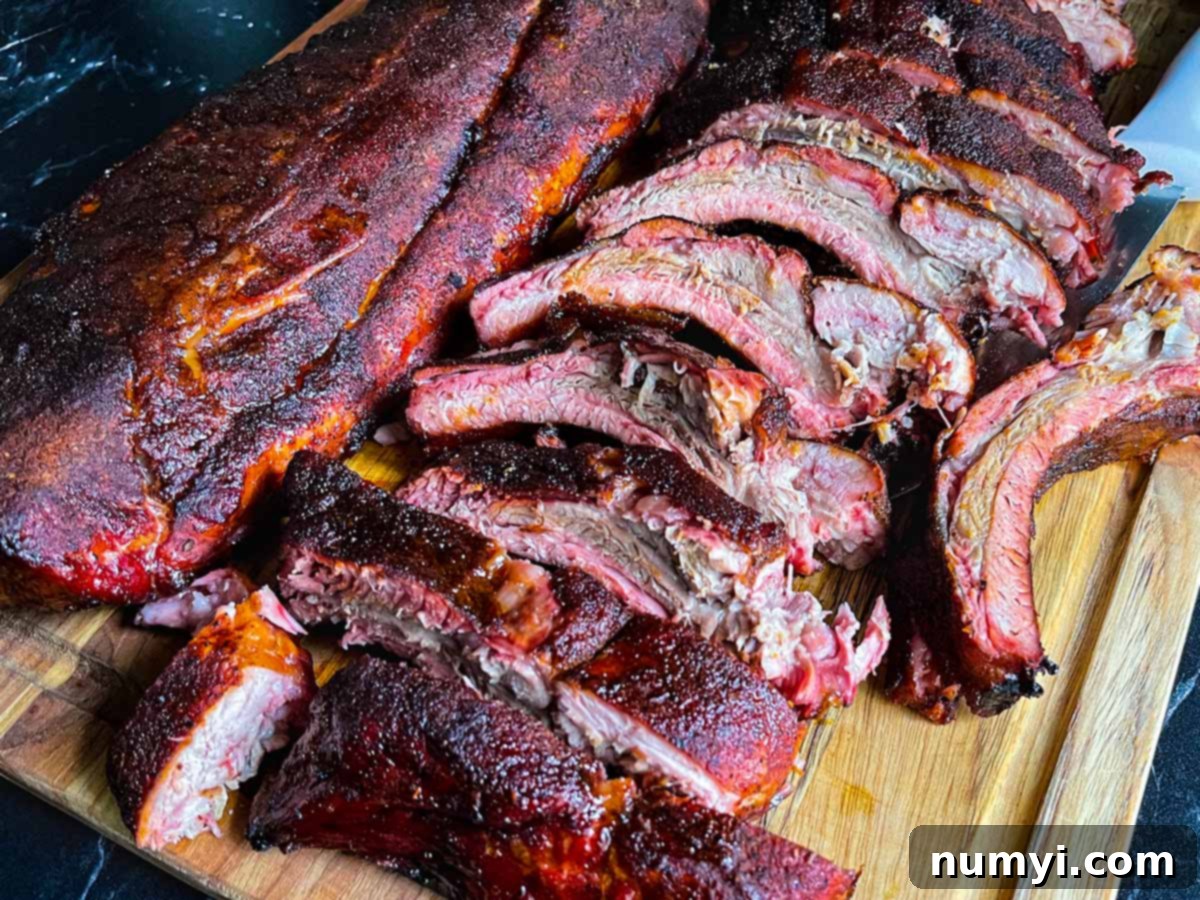Ultimate Guide to Smoked Memphis Style Baby Back Ribs: Tender & Flavorful
Are you ready to master the art of smoking a rack of baby back ribs that boasts a perfect balance of smoky depth and mouth-watering flavor? Look no further! This comprehensive guide will walk you through creating authentic Memphis-style smoked baby back ribs that are incredibly tender, juicy, and packed with an unforgettable taste. Prepare to impress your family and friends with barbecue perfection.

Why You Will Love This Recipe for Smoked Ribs
Smoked baby back ribs are more than just a meal; they’re a culinary experience that excites the senses. The magic truly happens through the slow smoking process, which infuses the succulent meat with an unparalleled depth of flavor. As the ribs cook “low and slow,” they absorb the rich, aromatic essence of the smoldering wood, creating a delightful symphony of smoky, sweet, and savory notes that dance on your palate.
The resulting texture is nothing short of perfection: incredibly tender meat that effortlessly pulls from the bone, complemented by the subtle caramelization of our signature dry rub. When paired with or without a tangy barbecue sauce, these ribs offer a harmonious blend of textures and flavors that is simply irresistible. Each bite delivers a burst of juiciness and tenderness, making these Memphis-style smoked baby back ribs the epitome of barbecue pleasure. They leave a lasting impression and an undeniable craving for more, establishing them as a must-have in any pitmaster’s repertoire.
Understanding Memphis Style Baby Back Ribs
For decades, backyard grillers and professional pitmasters alike have developed their own unique methods for crafting delicious ribs. My own journey into the world of barbecue has spanned over 20 years, during which I’ve smoked countless racks of ribs. It wasn’t until recent years, however, that I began to deeply explore the nuances of regional barbecue styles, uncovering the subtle yet distinct differences that define each tradition.
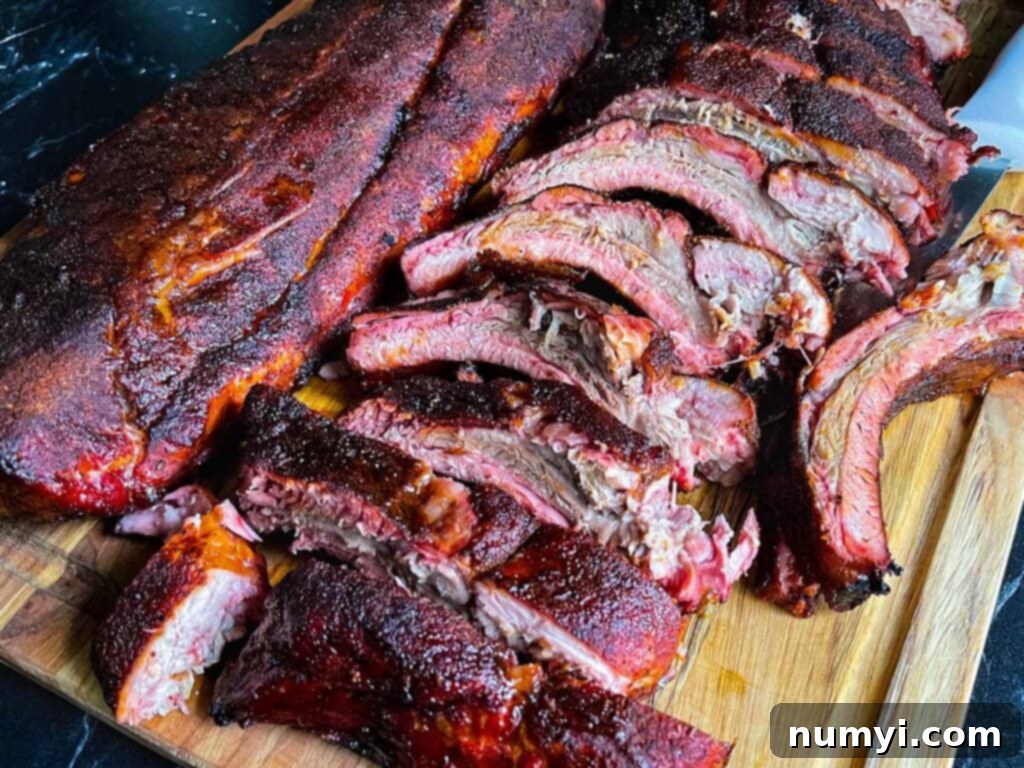
Through this exploration, I discovered that my personal preference has always leaned towards Memphis-style barbecue. This distinct style offers two primary ways to prepare ribs: wet or dry. Both methods share similar preparation steps up until the very end of the smoking process.
A **dry rib** is characterized by a generous application of a spice rub, cooked to perfection without any sauce added during or after. This allows the complex flavors of the rub and the natural smoky essence of the pork to truly shine. In contrast, a **wet rib** receives a coating of barbecue sauce in the final stages of cooking, allowing the sauce to “tack up” and caramelize slightly on the meat for a few minutes before serving. Both offer a phenomenal experience, but for true Memphis tradition, the dry rub is often celebrated.
Don’t Sweat The Recipe is supported by its readers. We may earn a commission if you purchase through a link on our site. Learn more.
Crafting the Perfect Memphis Rub for Ribs
The soul of Memphis-style barbecue lies in its distinctive rub, which prominently features paprika. Traditionally, the ratio often leans heavily towards paprika, usually two parts paprika to one part brown sugar. From this foundation, additional spices are incorporated, allowing each cook to personalize their blend. Our recipe embraces this philosophy, ensuring a rub that is not excessively sweet but offers subtle hints of heat from cayenne pepper, making it ideal for both ribs and pork shoulder.
Our carefully developed dry rub includes all the classic elements: salt, pepper, garlic powder, onion powder, and more. We’ve meticulously balanced these components to create a flavor profile that delivers a delightful touch of sweetness, savory depth, and a gentle warmth, all without overwhelming the natural taste of the pork ribs themselves. This versatile rub is so good, we even use it on our smoked pork shoulder!
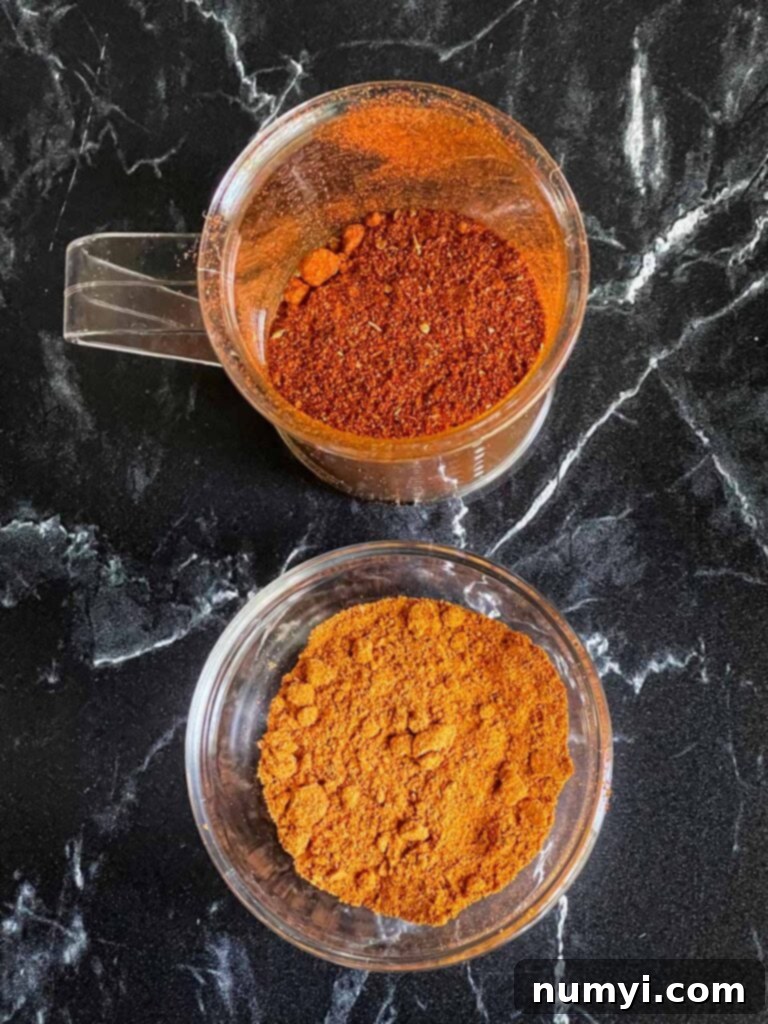
For an extra layer of flavor and a competitive edge, we highly recommend taking a portion of our Memphis rub and processing it into a fine “finishing dust” using a spice grinder. This magical dust, sprinkled over the ribs after they’re cooked, provides an incredible blast of concentrated flavor that elevates your ribs to a whole new level. If you don’t already own one, a spice grinder is a super affordable kitchen tool that will undoubtedly transform many of your dishes.
St. Louis Ribs Vs. Baby Back Ribs: Choosing Your Cut
When it comes to ribs, many ask: which cut is superior? The answer, ultimately, depends on your personal preference. Both St. Louis style ribs (which are spareribs) and baby back ribs offer distinct characteristics.
St. Louis ribs tend to have less meat and a higher fat content compared to baby backs. This extra fat renders beautifully during the long smoking process, resulting in an exceptionally juicy rib. On the other hand, baby back ribs are known for their abundant meatiness, providing a more substantial bite. However, this doesn’t mean baby back ribs aren’t moist; when cooked correctly, they are incredibly succulent. Whether you prefer the rich juiciness of St. Louis ribs or the hearty meatiness of baby backs, both can deliver a fantastic barbecue experience. I enjoy both, depending on my mood and what I’m serving alongside them!
Preparing Your Baby Back Ribs for Smoking
Proper preparation is key to achieving truly outstanding smoked ribs. Start by removing the baby back ribs from their packaging. Pat them thoroughly dry with paper towels, then place them on a large baking sheet. Drying the surface helps the rub adhere better and promotes a more desirable bark.
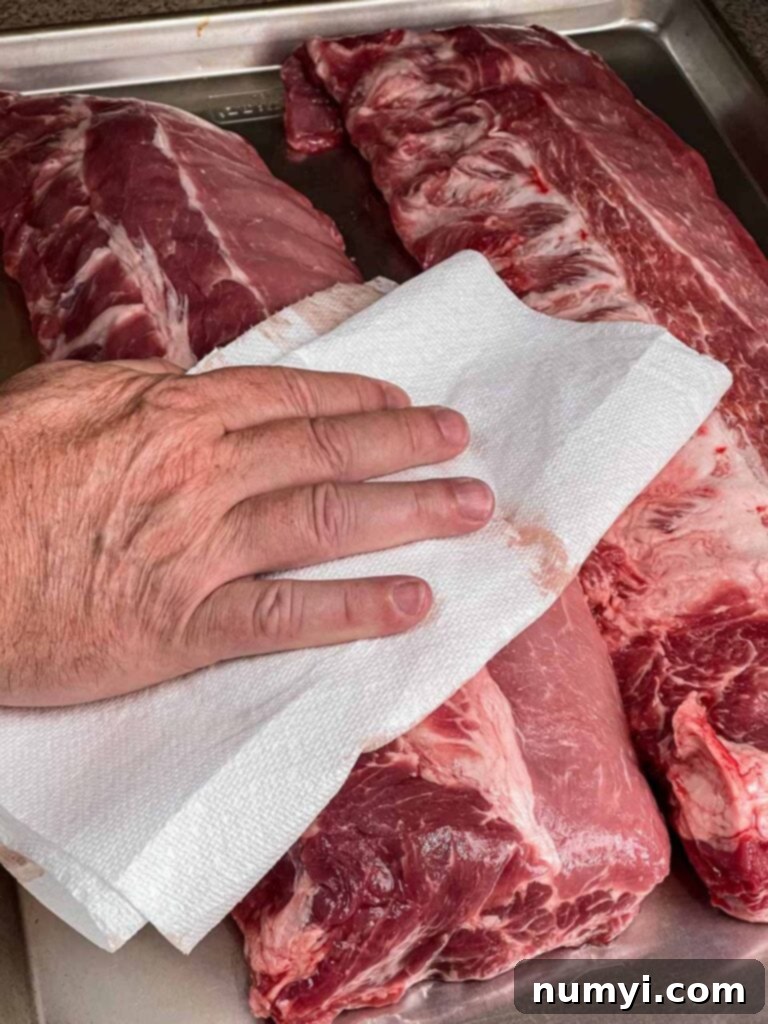
You’ll likely notice that baby back ribs naturally have less surface fat than spareribs, so extensive trimming isn’t usually required. However, always inspect your rack and trim away any excessive fat pockets or thin, loose pieces of meat. These smaller, thinner parts can easily burn and become tough during the long smoking process, affecting the overall quality and taste of your finished ribs.
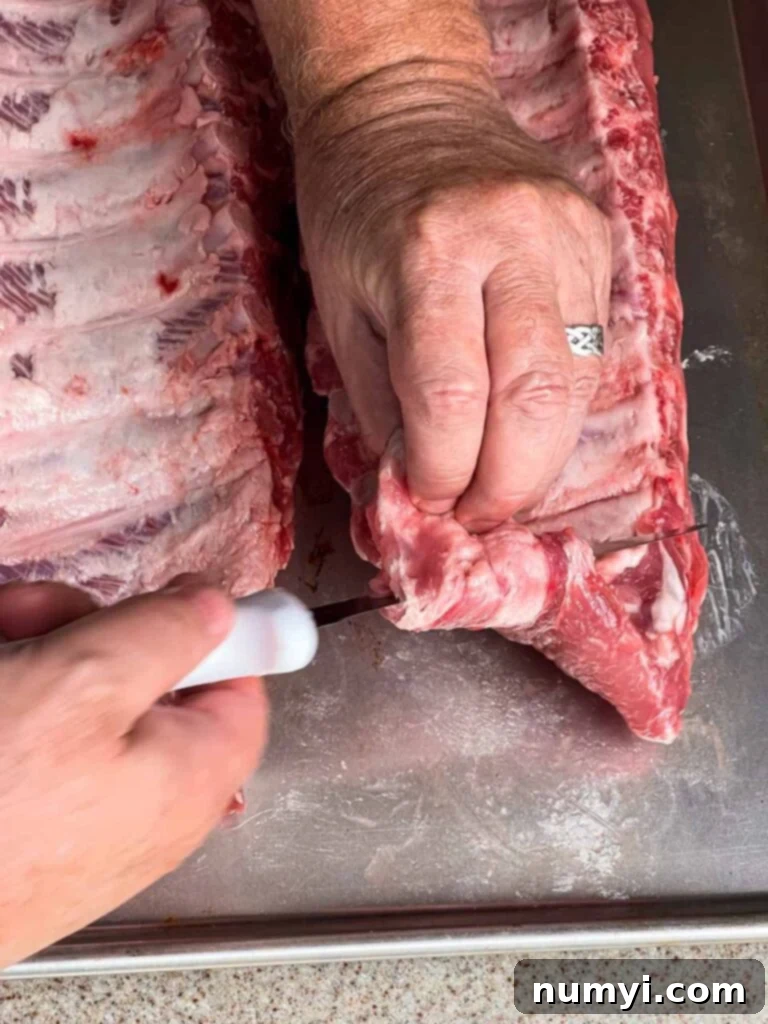
Next, flip the ribs so they are bone-side up. This is where you’ll address the silver skin, a tough membrane covering the bone side of the ribs. While some pre-packaged ribs come with this already removed, it’s crucial to check. To remove it, gently slide a butter knife or the edge of a spoon under the membrane at one end of the rack, working it loose from the bone. Once you have a small section to grip, use a paper towel for a firm hold and slowly pull the entire membrane away. This step is vital as the silver skin prevents the rub from penetrating and creates an unpleasantly chewy texture.
NOTE
You might have heard about using a binder like mustard on your ribs before applying the rub. While this is a common practice, it’s not strictly necessary. In fact, some argue that a thick binder can sometimes hinder the rub from adequately penetrating the meat. I personally used binders in the past, but have found that a well-prepared surface and sufficient rest time for the rub yields superior results without it.
Once trimmed and desilvered, generously apply your Memphis rub to both sides of the ribs. Don’t be shy – a good coating is essential for maximum flavor. Pat the rub gently into the meat to ensure it adheres well. Once fully coated, let the ribs rest for at least an hour before placing them in the smoker. This short dry brine period is crucial; it helps the ribs retain moisture, infuses the meat with the delicious spices from the rub, and contributes to the formation of that beautiful, flavorful bark.
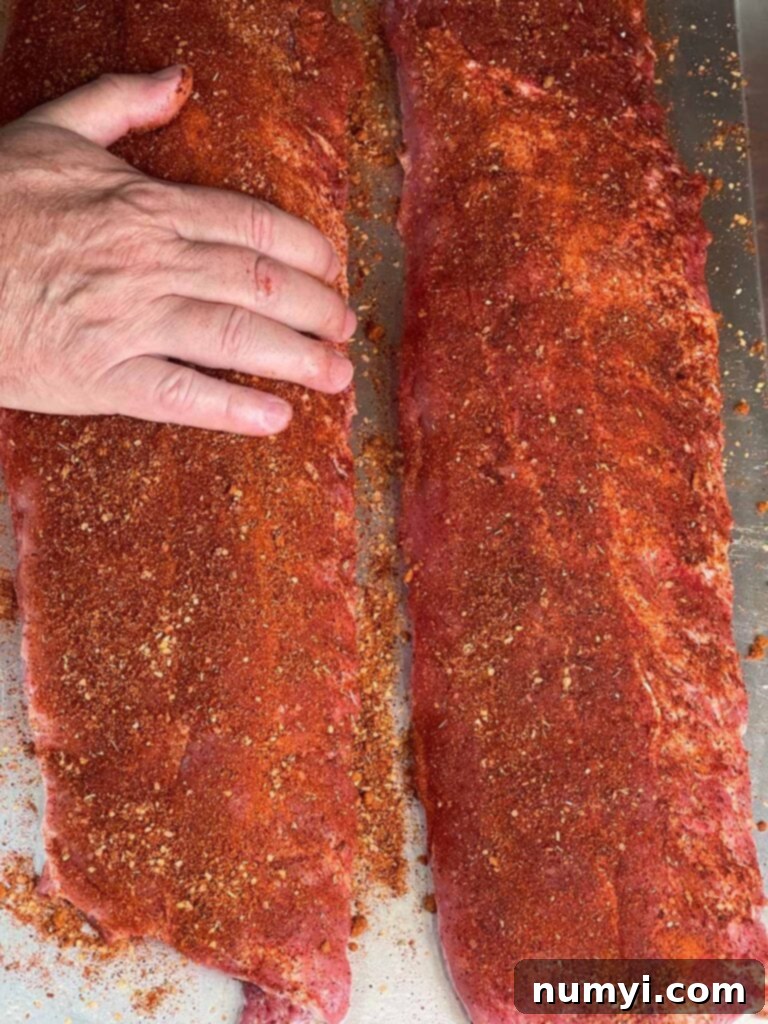
The Art of Smoking Memphis Style Ribs
Now for the main event: smoking your ribs to perfection. Preheat your smoker to a consistent 250 degrees Fahrenheit. The choice of wood is paramount for Memphis-style barbecue, with hickory being the traditional and highly recommended option for its strong, robust smoky flavor that pairs wonderfully with pork. I am a huge fan of hickory for its aggressive smoke profile, which I find perfect for both pork ribs and pork butts. If hickory isn’t available, oak and pecan are excellent alternatives that offer rich, complementary flavors. I also love to add a few chunks of cherry wood, not only for the beautiful reddish hue it imparts to the bark but also for the subtle sweetness it adds to the ribs. Any fruit wood, like apple or peach, would also be a fantastic choice. Remember, wood selection is ultimately a matter of personal preference, so feel free to experiment with your favorites.
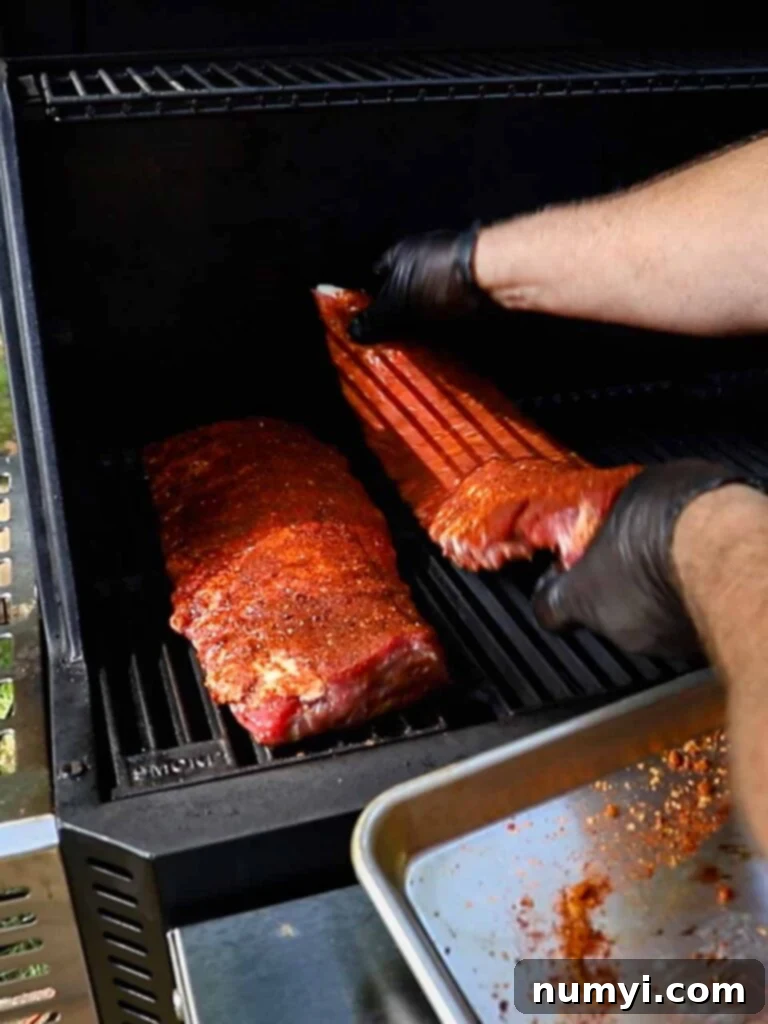
Once your smoker is at the target temperature and producing clean smoke, carefully place the ribs on the grates. Position them as far as possible from the direct heat source to ensure even cooking. If you’re smoking multiple racks, place smaller ones further away from the heat and larger, thicker racks closer to allow for more consistent heat absorption.
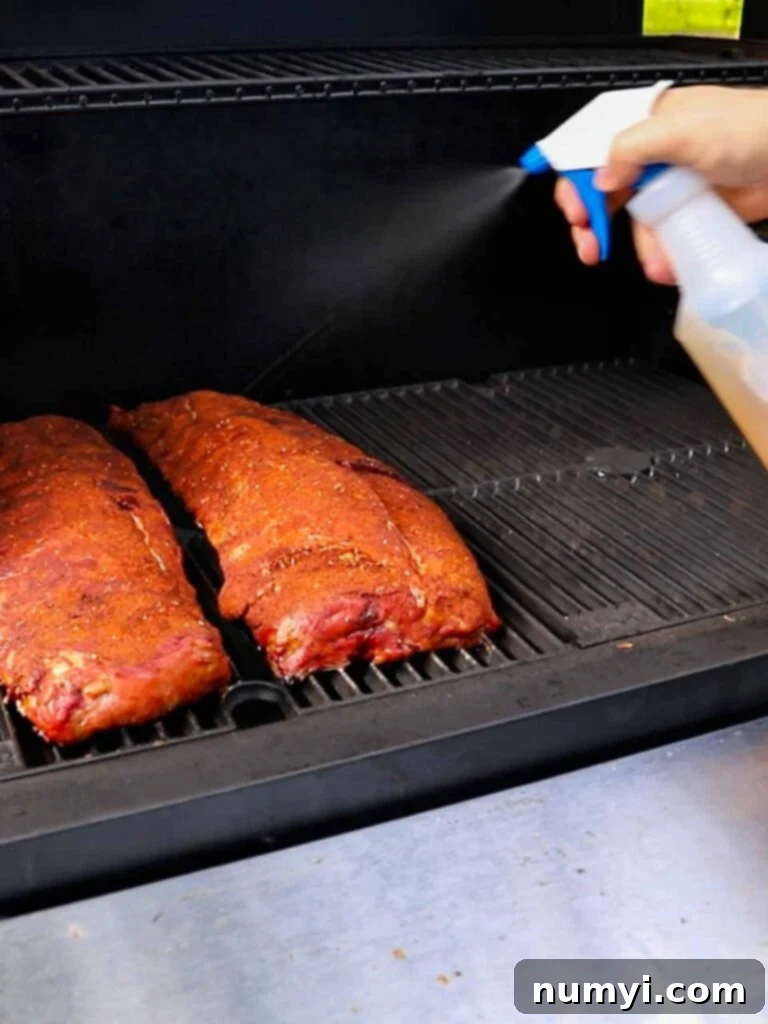
Close the smoker lid and let the ribs smoke for the first hour. After this initial hour, begin spritzing the ribs with a 50/50 mixture of water and apple cider vinegar. This spritzing process is crucial for maintaining moisture, helping to develop that desirable smoky bark, and adding a touch of tangy flavor. Continue to spritz the ribs every thirty minutes for the first three hours of cooking.
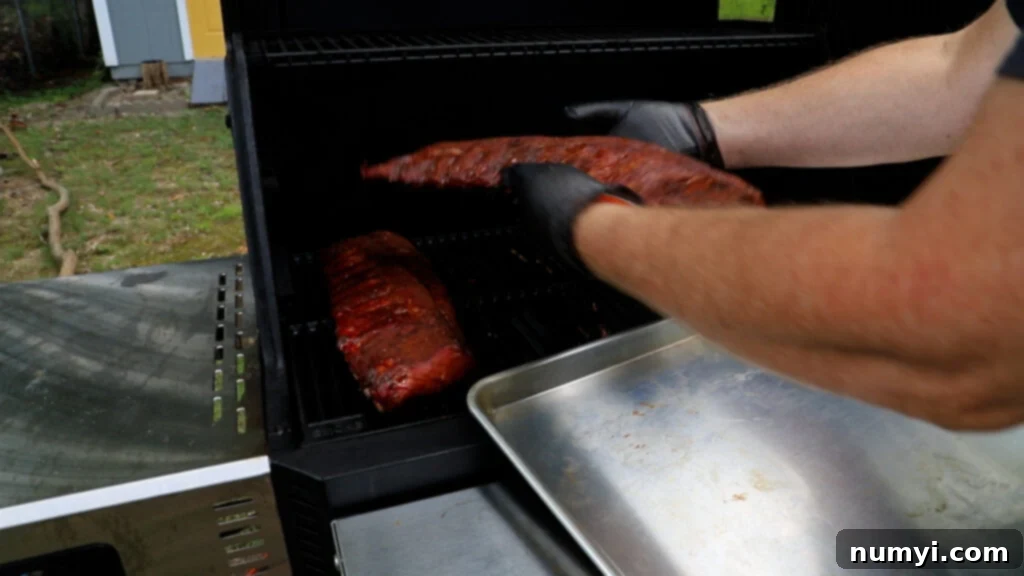
After three hours of smoking and regular spritzing, it’s time to move to the next phase. Carefully remove the ribs from the smoker. Prepare two large pieces of heavy-duty aluminum foil for wrapping each rack. On each piece of foil, place three pats of butter (approximately 1 tablespoon each), a tablespoon of apple cider vinegar, and a generous squeeze of honey (about 3 tablespoons). These ingredients will create a flavorful braising liquid, tenderizing the ribs and adding moisture and sweetness.
Place the ribs, bone-side up (upside down), directly on top of this mixture. This ensures the meaty side of the ribs bathes in the braising liquid. Wrap the heavy-duty aluminum foil fairly snugly around the ribs, being careful not to rip it. Return the wrapped ribs (still bone-side up) to the smoker and continue cooking for an additional hour.
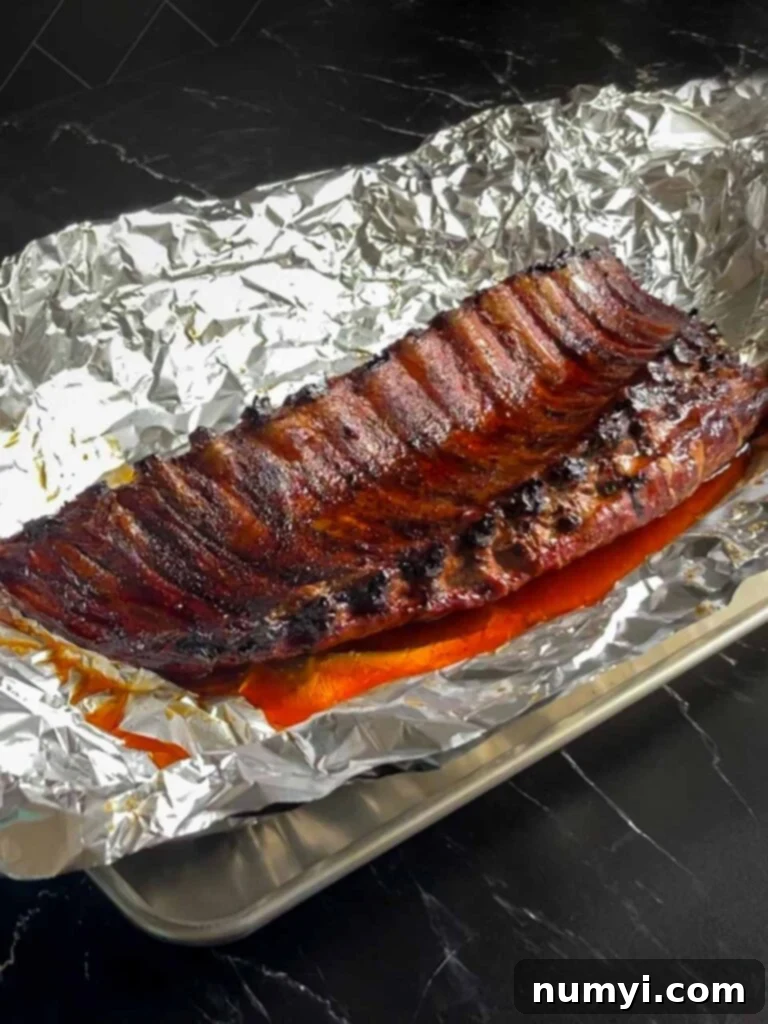
After this hour of wrapping and braising, remove the ribs from the aluminum foil and place them back onto the smoker, this time right side up. At this stage, you’ll want to start monitoring the internal temperature of the ribs and observe their flexibility. Since rib sizes can vary significantly, so too will their exact cooking time. We are aiming for a specific texture and internal temperature, not just a fixed cooking duration.
DRY RIB VS. WET RIB
This recipe focuses on Memphis-style dry ribs, which are finished with just the rub and optional finishing dust. However, if you prefer a Memphis wet rib, this is the time to apply your favorite barbecue sauce. Once the ribs are almost done, brush a thin, even layer of sauce over them and allow them to set on the smoker for about 15 minutes. This gives the sauce time to “tack up” and caramelize slightly without burning.
For that perfect clean, tender bite where the meat pulls off the bone without the entire rack falling apart, aim to pull your ribs off the smoker when they reach an internal temperature of 195 degrees Fahrenheit. An instant-read thermometer is your best friend here. In addition to temperature, you can also use the “rib bend” test to gauge doneness.
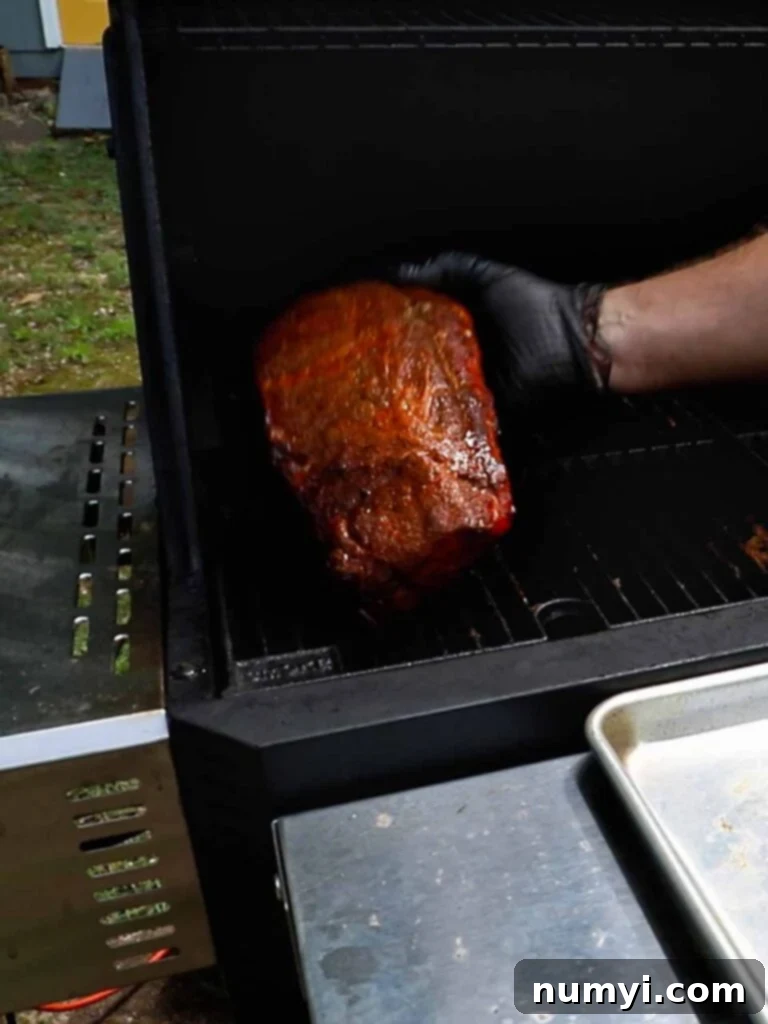
To perform the bend test, pick up the rack of ribs in the center with a pair of tongs and allow the ends to hang. A perfectly cooked rib will bend significantly, almost to the point of feeling like it’s about to fall apart, forming an angle similar to a half-circle. I always use a combination of the bend test and an internal temperature check to achieve the ideal tenderness. My wife, Leigh, prefers her ribs with a bit more tug, so I often aim for a happy medium that satisfies both preferences.
Once the ribs hit 195 degrees F and pass the bend test, remove them from the smoker. This is the moment to apply your special ground spice rub finishing dust, if you prepared it. Sprinkle this magical seasoning evenly over the hot ribs for an extra pop of flavor. Finally, allow the ribs to rest for at least 20 minutes. This resting period is crucial; it allows the juices to redistribute throughout the meat, resulting in a more tender and flavorful end product. Don’t worry, they’ll stay perfectly warm.
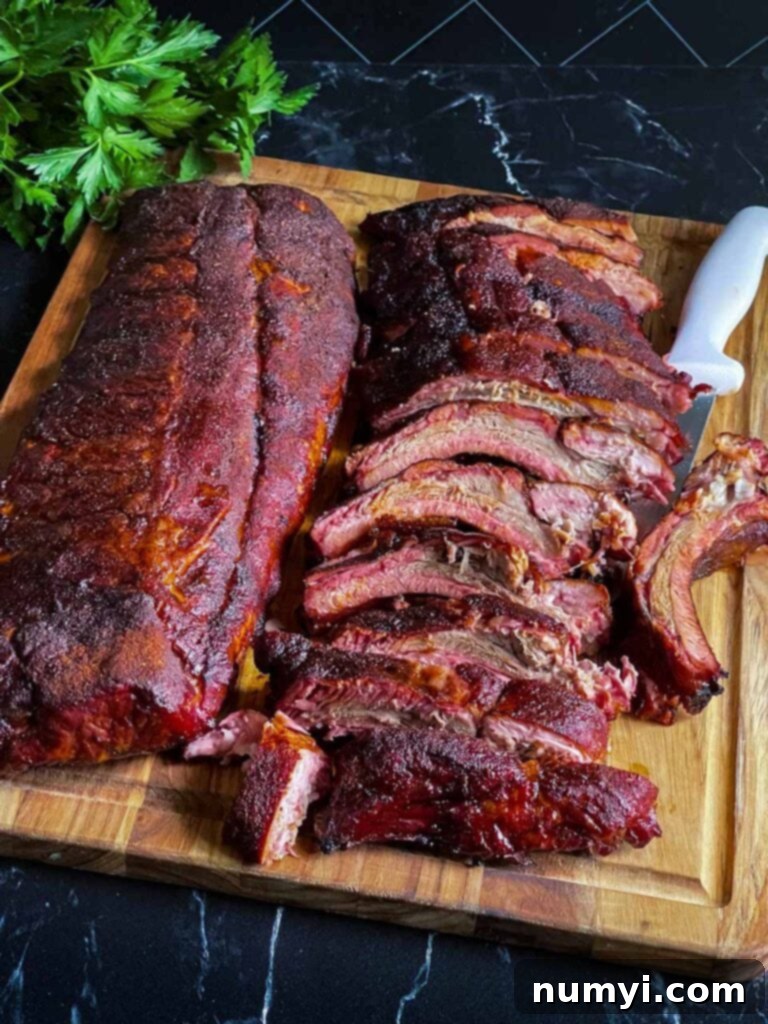
After the rest, flip the ribs over to easily locate the bones. Using a sharp knife, carefully cut the ribs into individual portions. Now, it’s time to plate them up and enjoy your masterpiece!
Time To Eat: Serving Your Smoked Baby Back Ribs
These incredible smoked Memphis-style baby back ribs are fantastic on their own, but they truly shine when served with your favorite classic barbecue sides. Nothing screams barbecue quite like a generous helping of barbecue baked beans. For a burst of color and fresh flavor, consider a vibrant summer succotash or a zesty grilled Mexican street corn salad. Both would be perfect complements to the rich, smoky ribs.
Or, if you’re like me, you might just find yourself cutting them straight off the board and enjoying them as-is! However you choose to serve them, you are guaranteed to love these authentic Memphis-style dry ribs. Get ready for rave reviews and empty plates!
Tips and Variations for Your Smoked Ribs
Elevate your rib game with these expert tips and exciting flavor variations:
- Charcoal Grill Method: Don’t have a dedicated smoker? No problem! You can achieve excellent results on a charcoal grill by setting it up for indirect heat. Place coals on one side and the ribs on the other, ensuring a consistent low temperature for smoking.
- Generous Seasoning: Always apply your dry rub or marinade generously. For the most profound flavor, allow the ribs to rest in the refrigerator for several hours, or ideally, overnight. This extended time allows the spices to deeply penetrate the meat.
- Maintain Moisture: To prevent your ribs from drying out during the long smoke, frequently spritz them with a liquid mixture (like our apple cider vinegar and water blend). Alternatively, place a water pan inside your smoker to maintain a humid environment, which helps keep the meat succulent.
- Asian-Inspired Ribs: For a delightful twist, marinate your baby back ribs in a blend of soy sauce, fresh ginger, minced garlic, and honey. Serve them with a drizzle of homemade teriyaki glaze for a truly unique and flavorful experience.
- Bourbon-Glazed Goodness: During the final hour of smoking, brush your ribs with a rich bourbon-based BBQ sauce or glaze. This creates a wonderfully caramelized coating with a sophisticated hint of smokiness and sweetness.
- Carolina-Style Tang: If you appreciate a tangy barbecue profile, opt for a vinegar-based marinade or a traditional Carolina mop sauce. Serve these zesty ribs with a side of creamy coleslaw for an authentic Southern experience.
Frequently Asked Questions About Smoking Ribs
The 3-2-1 rule is a popular technique for smoking ribs, particularly spareribs (St. Louis style). It involves smoking the ribs uncovered at a low temperature for three hours, then wrapping them tightly in foil with a liquid (like apple juice, beer, or apple cider vinegar) to gently braise in their own juices for another two hours. Finally, they are removed from the foil and finished for one hour, often with sauce or glaze, to set the bark. This method typically results in very tender, “fall-off-the-bone” ribs.
While the 3-2-1 method is excellent for achieving fall-off-the-bone tenderness, it really depends on your desired texture. Our personal preference is for ribs that offer a clean bite with a slight tug, where the meat stays on the bone when you bite it. If you enjoy that more traditional, slightly resistant texture, our method aims for that perfect balance. If you prefer the meat to practically melt off the bone, the 3-2-1 method might be more to your liking.
Yes, wrapping your ribs in foil during the smoking process is highly recommended. After about 3 hours of initial smoking, wrapping them, usually bone-side up, allows them to braise in their own juices along with any added liquids (like apple cider vinegar, butter, and honey in our recipe). This phase helps tenderize the pork significantly, prevent them from drying out, and ensures a moist, flavorful result. The duration of the wrap can be anywhere from 30 minutes to 2 hours, depending on your desired level of tenderness.
While pork is technically cooked at 145 degrees F, the magic for ribs happens when the fat and collagen begin to break down, which occurs around 190 degrees F. For a clean bite with a slight tug, we recommend pulling your ribs off the smoker at 195 degrees F. If you’re aiming for that ‘fall-off-the-bone’ texture, you’ll want to let them cook a bit longer, typically to an internal temperature of 200-205 degrees F.
Absolutely! Spritzing your ribs is a great way to keep them moist, promote bark formation, and add a layer of flavor. We recommend spritzing the ribs with a mixture of apple cider vinegar and water after the first hour of smoking, then every 30 minutes until you wrap them. Alternatively, you can use a mop sauce for a similar effect, which can also contribute additional flavors to the meat.
When wrapping your ribs, adding a small amount of liquid helps to create a steamy environment that tenderizes the meat. Apple juice is a popular and excellent choice, adding a subtle sweetness. Other great options include beer, Dr. Pepper for a sweeter profile, or simply more apple cider vinegar for tang. Water can also be used if you prefer to let the rub and smoke flavor dominate. The possibilities are truly endless, allowing you to customize the flavor.
The best kind of rub for ribs largely depends on the regional barbecue style you’re aiming for and your personal taste preferences. Our favorite, as highlighted in this recipe, is Memphis style. This rub offers a fantastic balance of decent spiciness, a savory depth, and is not overly sweet, allowing the natural flavor of the pork to shine through while complementing it beautifully. Experiment with different regional rubs to find your personal favorite!
Other Scrumptious Barbecue Recipes
Fall Off The Bone St Louis Style Ribs
St. Louis Ribs – Learn How To Do Smoked Ribs Like A Pro
Smoked Pork Shoulder (Pork Butt)
Are you on Pinterest? Click the button below to add this recipe to one of your boards!
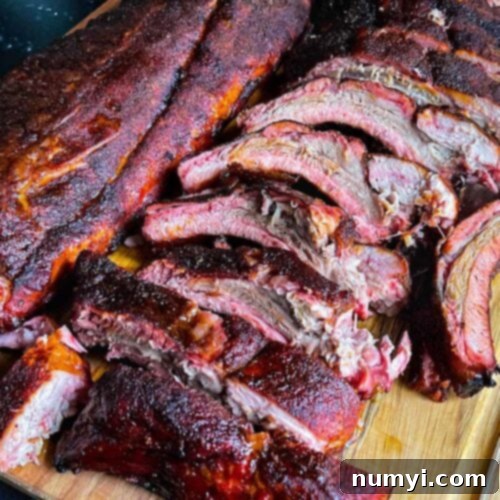
Memphis Style Baby Back Ribs Recipe
Print
Pin
Rate
Equipment
-
Smoker We use a Masterbuilt Gravity Series 1050
Ingredients
The Ribs
- 1 rack Pork baby back ribs
Memphis Style Rub
- 1/2 cup Paprika
- 2 tbsp Smoked paprika
- 2 tbsp Garlic powder
- 1/4 cup Chili powder
- 3 tbsp Kosher salt
- 3 tbsp Black pepper
- 3 tbsp Brown sugar packed
- 2 tbsp Onion powder
- 1 tbsp Dried oregano
- 1 tbsp Cumin
- 2 tsp Dried mustard
- 1 tsp Cayenne powder
The Wrap
- 2 tbsp Apple cider vinegar
- 3 tbsp Butter
- 3 tbsp Honey
Instructions
-
Remove the membrane (silver skin) from the back side of the ribs.
-
Trim off any bits and pieces that will will burn off during the smoking process.
-
Generously apply rub on both sides of the ribs, patting in the rub.
-
Allow ribs to rest for one hour before smoking (dry brine).
-
Get the smoker to 250 degrees F and use your preferred wood (we recommend hickory).
-
Place ribs into the smoker and allow to smoke for 3 hours.
-
Wrap the ribs in aluminum foil with the apple cider vinegar, butter, and honey. Make sure the ribs are bone side up so the meaty part of the ribs are in the braising ingredients.
-
Place back onto the smoker for one hour.
-
Remove the ribs from the smoker. Take them out of the aluminum foil.
-
Place back onto the smoker for an additional hour.
-
Check for doneness by using an instant-read thermometer. Pull the ribs off at 195 degrees F. For fall-off-the-bone, pull them at 200-205 degrees F.
-
Allow to rest for 20 to 30 minutes then cut them into individual ribs.
-
Enjoy!
Notes
This recipe is for Memphis Style Dry Ribs. If you want a Memphis Wet rib, apply your favorite sauce thinly to the ribs 20 minutes before pulling them off the smoker.
Nutrition
